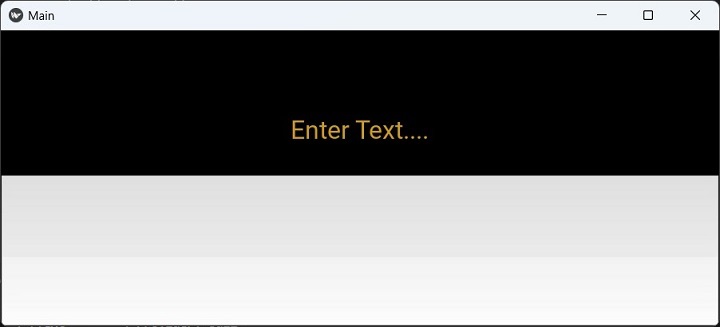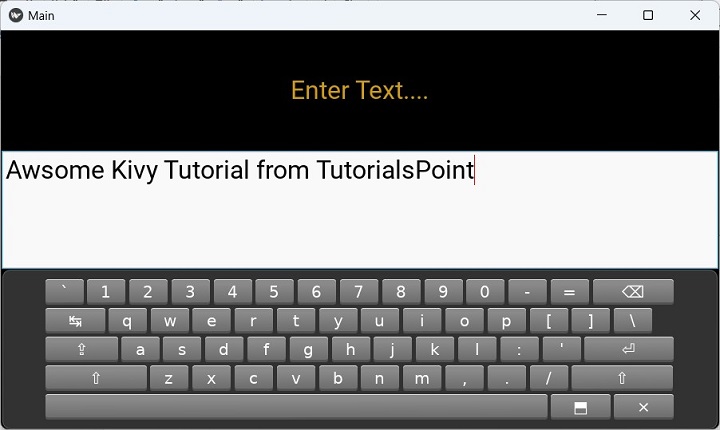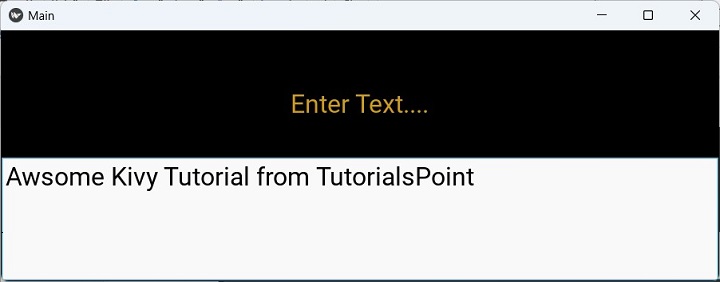
- Kivy Tutorial
- Kivy - Home
- Kivy Basics
- Kivy - Getting Started
- Kivy - Installation
- Kivy - Architecture
- Kivy - File Syntax
- Kivy - Applications
- Kivy - Hello World
- Kivy - App Life Cycle
- Kivy - Events
- Kivy - Properties
- Kivy - Inputs
- Kivy - Behaviors
- Kivy Buttons
- Kivy - Buttons
- Kivy - Button Events
- Kivy - Button Colors
- Kivy - Button Size
- Kivy - Button Position
- Kivy - Round Buttons
- Kivy - Disabled Buttons
- Kivy - Image Button
- Kivy Widgets
- Kivy - Widgets
- Kivy - Label
- Kivy - Text Input
- Kivy - Canvas
- Kivy - Line
- Kivy - Checkbox
- Kivy - Dropdown List
- Kivy - Windows
- Kivy - ScrollView
- Kivy - Carousel
- Kivy - Slider
- Kivy - Images
- Kivy - Popup
- Kivy - Switch
- Kivy - Spinner
- Kivy - Splitter
- Kivy - Progress Bar
- Kivy - Bubble
- Kivy - Tabbed Panel
- Kivy - Scatter
- Kivy - Accordion
- Kivy - File Chooser
- Kivy - Color Picker
- Kivy - Code Input
- Kivy - Modal View
- Kivy - Toggle Button
- Kivy - Camera
- Kivy - Tree View
- Kivy - reStructuredText
- Kivy - Action Bar
- Kivy - Video Player
- Kivy - Stencil View
- Kivy - VKeyboard
- Kivy - Touch Ripple
- Kivy - Audio
- Kivy - Videos
- Kivy - Spelling
- Kivy - Effects
- Kivy - Input Recorder
- Kivy - OpenGL
- Kivy - Text
- Kivy - Text Markup
- Kivy - Settings
- Kivy Layouts
- Kivy - Layouts
- Kivy - Float Layout
- Kivy - Grid Layouts
- Kivy - Box Layouts
- Kivy - Stack Layout
- Kivy - Anchor Layout
- Kivy - Relative Layout
- Kivy - Page Layout
- Kivy - Recycle Layout
- Kivy - Layouts in Layouts
- Kivy Advanced Concepts
- Kivy - Configuration Object
- Kivy - Atlas
- Kivy - Data Loader
- Kivy - Cache Manager
- Kivy - Console
- Kivy - Animation
- Kivy - Multistroke
- Kivy - Clock
- Kivy - SVGs
- Kivy - UrlRequest
- Kivy - Clipboard
- Kivy - Factory
- Kivy - Gesture
- Kivy - Language
- Kivy - Graphics
- Kivy - Drawing
- Kivy - Packaging
- Kivy - Garden
- Kivy - Storage
- Kivy - Vector
- Kivy - Utils
- Kivy - Inspector
- Kivy - Tools
- Kivy - Logger
- Kivy - Framebuffer
- Kivy Applications and Projects
- Kivy - Drawing App
- Kivy - Calculator App
- Kivy - Stopwatch App
- Kivy - Camera Handling
- Kivy - Image Viewer
- Kivy - Bezier
- Kivy - Canvas Stress
- Kivy - Circle Drawing
- Kivy - Widget Animation
- Kivy - Miscellaneous
- Kivy Useful Resources
- Kivy - Quick Guide
- Kivy - Useful Resources
- Kivy - Discussion
Kivy - VKeyboard
The VKeyboard widget in Kivy library is especially useful for applications running on multitouch devices such as smartphones and tablets. VKeyboard is an on-screen keyboard. Its operation is intended to be transparent to the user.
The VKeyboard is used in two modes − docked and free mode. The free mode is suitable for multitouch devices, whereas the docked mode is enabled while using a computer like a tablet.
The VKeyboard class is defined in kivy.uix.vkeyboard module.
from kivy.uix.vkeyboard import VKeyboard kb = VKeyboard(**kwargs)
A virtual keyboard is never used directly. Instead, it is controlled by the configuration. If the application has any widget (such as TextInput) that requires a keyboard, do not use the virtual keyboard directly, but prefer to use the best method available on the platform.
The VKeyboard class inherits the ScatterLayout. A button in the bottom right of the virtual keyboard widget lets you switch between available layouts.
The VKeyboard object has the following properties −
available_layouts − Dictionary of all available layouts. Keys are the layout ID, and the value is the JSON, defaults to {}.
callback − Callback can be set to a function that will be called if the VKeyboard is closed by the user.
docked − Indicate whether the VKeyboard is docked on the screen or not. If you change it, you must manually call setup_mode() otherwise it will have no impact.
key_margin − Key margin, used to create space between keys. The margin is composed of four values, in pixels −
key_margin = [top, right, bottom, left]
key_margin defaults to [2, 2, 2, 2]
target − Target widget associated with the VKeyboard. If set, it will be used to send keyboard events.
Example
In the following example, the initial constitution of a one-column grid layout shows a label and a TextInput widget. As the user generates a touch_down event by clicking inside the text box, a VKeyboard widget is added to the layout.
def ontouch(self, instance, value):
self.kb = VKeyboard(
on_key_up = self.vkbinput,
pos_hint={'center_x':.5},
size_hint=(.8, None)
)
self.layout.add_widget(self.kb)
When any key on the keyboard is pressed, it generates on_key_up event. It is bound to a vkbinput() method. This method reads the keycode of the depressed key and updates the contents of the text box.
def vkbinput(self, keyboard, keycode, *args):
text = self.text1.text
if keycode == '~':
self.layout.remove_widget(self.kb)
return
self.text1.text = f'{text}{keycode}'
Whenever the user presses the "~" key, the keyboard widget is removed from the layout.
The complete code is given below −
from kivy.app import App
from kivy.uix.vkeyboard import VKeyboard
from kivy.uix.textinput import TextInput
from kivy.uix.label import Label
from kivy.uix.gridlayout import GridLayout
from kivy.core.window import Window
Window.size = (720, 400)
class MainApp(App):
def build(self):
self.layout = GridLayout(cols=1)
self.text1 = TextInput(
font_size=32,
on_touch_down=self.ontouch
)
self.label = Label(
text="Enter Text....",
font_size=32,
color=[.8, .6, .1]
)
self.layout.add_widget(self.label)
self.layout.add_widget(self.text1)
return self.layout
def ontouch(self, instance, value):
self.kb = VKeyboard(
on_key_up=self.vkbinput,
pos_hint={'center_x': .5},
size_hint=(.8, None)
)
self.layout.add_widget(self.kb)
def vkbinput(self, keyboard, keycode, *args):
text = self.text1.text
if keycode == '~':
self.layout.remove_widget(self.kb)
return
self.text1.text = f'{text}{keycode}'
MainApp().run()
Output
When the above code runs, the initial display of the app window is like this −

Click inside the textbox, and the virtual keyboard appears below it −

You can now enter the text. Press "~" to remove the keyboard.

To Continue Learning Please Login